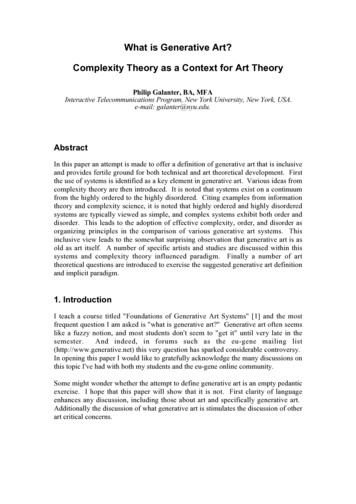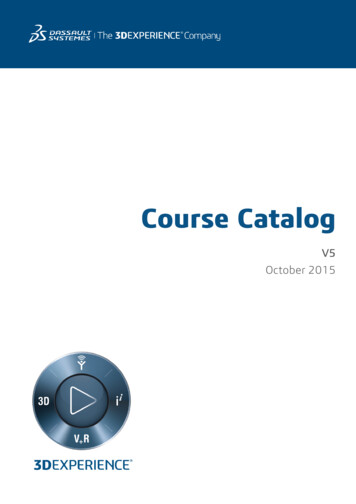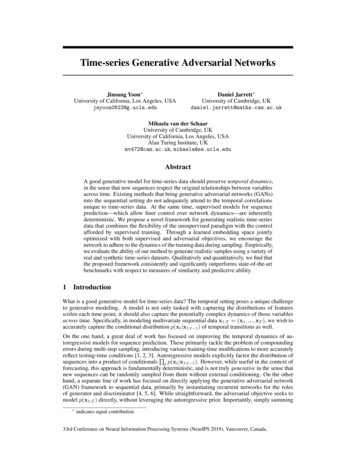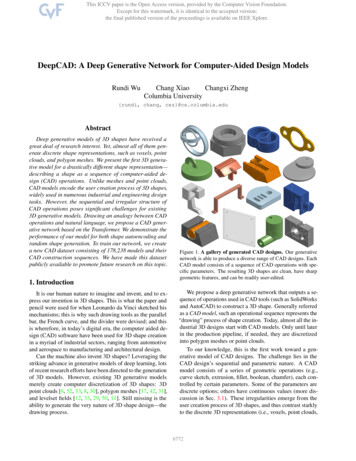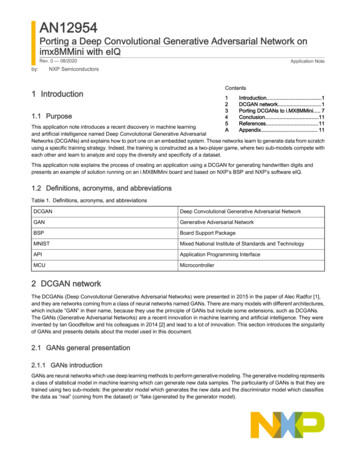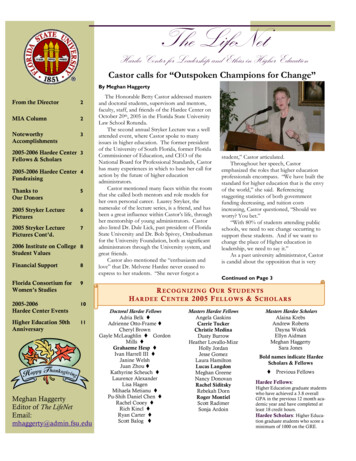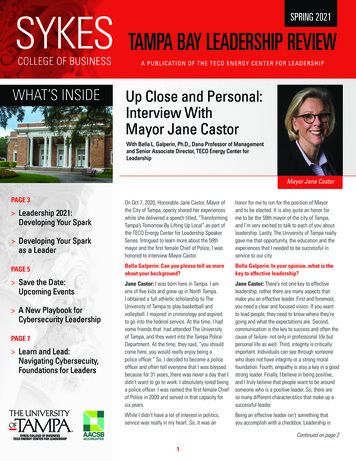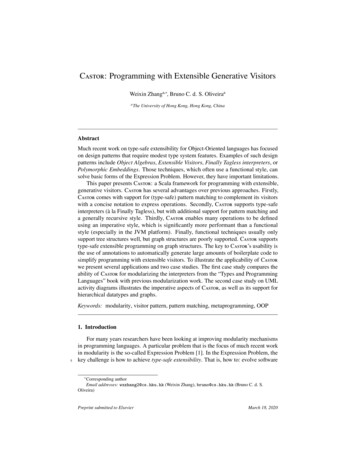
Transcription
Castor: Programming with Extensible Generative VisitorsWeixin Zhanga, , Bruno C. d. S. Oliveiraaa TheUniversity of Hong Kong, Hong Kong, ChinaAbstractMuch recent work on type-safe extensibility for Object-Oriented languages has focusedon design patterns that require modest type system features. Examples of such designpatterns include Object Algebras, Extensible Visitors, Finally Tagless interpreters, orPolymorphic Embeddings. Those techniques, which often use a functional style, cansolve basic forms of the Expression Problem. However, they have important limitations.This paper presents Castor: a Scala framework for programming with extensible,generative visitors. Castor has several advantages over previous approaches. Firstly,Castor comes with support for (type-safe) pattern matching to complement its visitorswith a concise notation to express operations. Secondly, Castor supports type-safeinterpreters (à la Finally Tagless), but with additional support for pattern matching anda generally recursive style. Thirdly, Castor enables many operations to be definedusing an imperative style, which is significantly more performant than a functionalstyle (especially in the JVM platform). Finally, functional techniques usually onlysupport tree structures well, but graph structures are poorly supported. Castor supportstype-safe extensible programming on graph structures. The key to Castor’s usability isthe use of annotations to automatically generate large amounts of boilerplate code tosimplify programming with extensible visitors. To illustrate the applicability of Castorwe present several applications and two case studies. The first case study compares theability of Castor for modularizing the interpreters from the “Types and ProgrammingLanguages” book with previous modularization work. The second case study on UMLactivity diagrams illustrates the imperative aspects of Castor, as well as its support forhierarchical datatypes and graphs.Keywords: modularity, visitor pattern, pattern matching, metaprogramming, OOP1. Introduction5For many years researchers have been looking at improving modularity mechanismsin programming languages. A particular problem that is the focus of much recent workin modularity is the so-called Expression Problem [1]. In the Expression Problem, thekey challenge is how to achieve type-safe extensibility. That is, how to: evolve software CorrespondingauthorEmail addresses: wxzhang2@cs.hku.hk (Weixin Zhang), bruno@cs.hku.hk (Bruno C. d. S.Oliveira)Preprint submitted to ElsevierMarch 18, 2020
101520253035404550in two dimensions (adding new variants and operations) without rewriting existing code;and without using type-unsafe features (such as casts or reflection). Over the years,many solutions were proposed. Some work proposes new programming languages orprogramming language features designed specifically with modularity in mind. Theseinclude virtual classes [2], multi-methods [3], and family polymorphism [4]. Other workhas focused on more general language features – such as generics [5], higher-kindedtypes [6], virtual types [7], traits [8] and mixins [5] – which can also help with variousmodularity problems.Much of the more recent work on type-safe extensibility for Object-Oriented languages focus is on design patterns that require modest type system features. Examplesof such design patterns include Object Algebras [9], Modular Visitors [10], FinallyTagless interpreters [11] or Polymorphic Embeddings [12]. All of those techniques cansolve basic forms of the Expression Problem, and are closely related.The foundation for a lot of that work comes from functional programming andtype-theoretic encodings of datatypes [13, 14]. In particular, the work by Hinze [15] wasthe precursor for those techniques. In his work Hinze employed so-called Church [13]and Scott [14] encodings of datatypes to model generic programming libraries. LaterOliveira et al. [16, 17] showed that variants of those techniques have wider applicationsand solve the Expression Problem [1]. These ideas were picked up by Carrete et al. [11]to enable tagless interpreters, while also benefited from the extensibility properties ofthe techniques. Carrete et al.’s work popularized those applications of the techniquesas the nowadays so-called Finally Tagless style. Soon after Hofer et al. [12] proposedPolymorphic Embeddings in Scala, highly inspired by the Finally Tagless style inlanguages like Haskell and OCaml.In parallel with the work on Finally Tagless and Polymorphic Embeddings theconnections of those techniques to the Visitor pattern in OOP were further explored [18],building on observations between the relationship between type-theoretic encodings ofdatatypes and visitors by Buchlovsky and Thielecke [19]. That work showed that Churchand Scott encodings of datatypes correspond to two variants of the Visitor pattern called,respectively, Internal and External visitors. Later on Oliveira and Cook [9] showed asimplified version of Internal Visitors called Object Algebras, which could solve theExpression Problem even in languages like Java.While Internal Visitors, Object Algebras, Finally Tagless or Polymorphic Embeddings can all be traced back to Church encodings, there has been much less work ontechniques that are based on Scott encodings. Scott encodings are more powerful, asthey allow a (generally) recursive programming style. In contrast, Church encodingsrely on a programming style that is akin to programming with folds in functional programming [20]. In general, Scott encodings require more sophisticated type systemfeatures, which is one reason why they have seen less adoption. In particular recursivetypes are necessary, which also brings up extra complications due to the interaction ofrecursive types and subtyping. Nevertheless, recent work by Zhang and Oliveira [21] onthe Java EVF framework picked up on modular External Visitors and shows ExternalVisitors can be made practical even with modest language features and code generation.The applicability of EVF is demonstrated by refactoring interpreters from the “Typesand Programming Languages” (TAPL) book [22]. The interpreters are modularized, andvarious specific interpreters are recovered from modular, reusable components. This2
5560657075808590effort is non-trivial because TAPL interpreters are written in a small-step operationalsemantics style, which does not fit well with folds. The fundamental problem is thatthe recursion pattern for small-step operational semantics is quite different from a fold.Furthermore, many operations employed by implementations of TAPL interpretersdepend on other operations. Such dependencies are hard to model in a modular setting,but the use of EVF’s External Visitors can account for them. However, there are stillcritical limitations on existing type-safe extensibility approaches, including EVF. Onedrawback is the lack of support for pattern matching, which makes writing various operations quite cumbersome. Another drawback is that even for the techniques that havebeen adapted to Object-Oriented Programming (OOP), the focus is still on a functionalprogramming style. Writing operations in an imperative style is difficult, and supportinggraph structures (which are common in OOP) is nearly impossible.This paper presents Castor: a Scala framework for programming with extensible,generative visitors. Unlike previous work, Castor aims to support not only a functionalstyle but also an imperative programming style with visitors. Castor visitors bringseveral advantages over existing approaches:Concise Notation. Programming with the Visitor pattern is typically associated with alot of boilerplate code. Extensible Visitors make the situation even worse due to the heavyuse of sophisticated type system features. Although previous work on EVF alleviated theburden of programmers by generating boilerplate code related to visitors and traversals,it is restricted by Java’s syntax and annotation processor. Castor improves on EVFby employing Scala’s concise syntax and Scalameta1 to simplify client code. Unlikethe Java annotation processor which generates code separately, Scalameta enablesdirect transformation on the client code, further reducing the boilerplate and hidingsophisticated type system features from users.Pattern Matching Support. Castor comes with support for (type-safe) pattern matchingto complement its visitors with a concise notation to express operations. In the OOPcontext, data structures are open. However, the traditional semantics of pattern matchingadopted by many approaches is based on the order of patterns, which conflicts with theopenness of OO data structures. Therefore, we suggest that a more restricted, top-levelpattern matching model, where the order of patterns is irrelevant. To compensate for theabsence of ordered patterns we propose a complementary mechanism for case analysiswith defaults, which can be used when nested or multiple case analysis is needed.Castor adopts this new pattern matching model. As a result, pattern matching in Castoris concise, exhaustive, extensible and composable.GADT-Style Definitions. Castor supports type-safe interpreters (à la Finally Tagless),but with additional support for pattern matching and a generally recursive style. WhileFinally Tagless interpreters are nowadays widely used by programmers in multiplelanguages (including Haskell and Scala), they must be written in fold-like style. Supporting operations that require nested patterns, or simply depend on other operations is1 http://scalameta.org3
quite cumbersome (although workarounds exist [23]), especially if modularity is to bepreserved. In contrast, Castor can support those features naturally.95100105110115Hierarchical Datatypes. Functional datatypes are typically flat where variants haveno relationship with each other. Object-oriented style datatypes, on the other hand,can be hierarchical [24] where datatype constructors can be refined by more specificconstructors. Hierarchical datatypes facilitate reuse since the subtyping relation allowsthe semantics defined for supertypes to be reused for subtypes. Castor exploits OOPfeatures and employs subtyping to model hierarchical datatypes.Imperative Traversals. Castor enables many operations to be defined using an imperative style, which is significantly more performant than a functional style (especially inthe JVM platform). Both functional and imperative visitors [19] written with Castorare fully extensible and can later support more variants modularly. Imperative visitorsenable imperative style traversals that instead of returning a new Abstract Syntax Tree(AST), modify an existing AST in-place.Graph Structures. Finally functional techniques usually only support tree structureswell, but graph structures are poorly supported. Castor supports type-safe extensibleprogramming on graph structures. Compared to trees, graphs are a more generaldata structure that have many important applications such as common subexpressionelimination.In summary, this paper makes the following contributions: Extensible pattern matching with modular external visitors: We evaluateexisting approaches to pattern matching in an OOP context (Section 2). We showhow to incorporate extensible (or open) pattern matching support on modularexternal visitors, which allows Castor to define non-trivial pattern matchingoperations. Support for hierarchical datatypes: Besides flat datatypes that are typicallymodeled in functional languages, we show how OOP style hierarchical datatypesare supported in Castor (Section 3).120 Support for GADTs: We show how to use Castor’s support for GADTs inbuilding well-typed interpreters (Section 4), which would be quite difficult tomodel in a Finally Tagless style. Imperative style modular external visitors: We show how to define imperativestyle modular external visitors in Castor (Section 5).125130 Support for graph structures: We show how to do type-safe extensible programming on graph structures, which generalize the typical tree structures infunctional programming (Section 5). The Castor framework: We present a novel encoding for modular patternmatching based on extensible visitors (Section 2.7). The encoding is automatedusing metaprogramming and the transformation is formalized (Section 6).4
Case studies: We conduct two case studies to illustrate the effectiveness ofCastor. The first case study on TAPL interpreters (Section 7) demonstratesfunctional aspects of Castor, while the second one on UML activity diagrams(Section 8) demonstrates the object-oriented aspects of Castor.135140This paper is a significantly extended version of a conference paper [25]. We revisethe presentation of the paper and more importantly extend Castor with novel features.Firstly, we add a detailed comparison with our previous work on EVF (Section 2.8).Secondly, we improve the way of declaring variants of open datatypes, which enableshierarchical variants (Section 3), GADTs (Section 4), graphs and imperative stylevisitors (Section 5). Thirdly, we revise the formalization according to the new encoding(Section 6). Finally, we conduct an additional case study on UML activity diagrams(Section 8) for assessing these added features.Source code for examples, case studies and the Castor framework is available at:https://github.com/wxzh/Castor1451501551602. Open Pattern MatchingPattern matching is a pervasive and useful feature in functional languages (e.g.ML [26] and Haskell [27]) for processing data structures conveniently. Data structuresare firstly modeled using algebraic datatypes and then processed through pattern matching. On the other hand, OOP uses class hierarchies instead of algebraic datatypes tomodel data structures. Still, the same need for processing data structures also existsin OOP. However, there are important differences between data structures modeledwith algebraic datatypes and class hierarchies. Algebraic datatypes are typically closed,having a fixed set of variants. In contrast, class hierarchies are open, allowing theaddition of new variants. A closed set of variants facilitates exhaustiveness checking ofpatterns but sacrifices the ability to add new variants. OO class hierarchies do supportthe addition of new variants, but without mechanisms similar to pattern matching, someprograms are unwieldy and cumbersome to write. In this section, we first characterizefour desirable properties of pattern matching in the context of OOP. We then reviewsome of the existing pattern matching approaches in OOP and discuss why they fall inshort of the desirable properties. This section ends with an overview of Castor and anevaluation summary on the presented approaches.2.1. Desirable Properties of Open Pattern MatchingWe identify the following desirable properties for pattern matching in an OOPcontext:165 Conciseness. Patterns should be described concisely with potential support forwildcards, deep patterns, and guards. Exhaustiveness. Patterns should be exhaustive to avoid runtime matching failure.The exhaustiveness of patterns should be statically verified by the compiler andthe missing cases should be reported if patterns are incomplete.5
170175180185190195200205210 Extensibility. Datatypes should be extensible in the sense that new data variantscan be added while existing operations can be reused without modification orrecompilation. Composability. Patterns should be composable so that complex patterns can bebuilt from smaller pieces. When composing overlapped patterns, programmersshould be warned about possible redundancies.Using these properties as criteria, we next evaluate pattern matching approachesin OOP. We show that many widely used approaches lack some of these properties.We argue that a problem is that many approaches try to closely follow the traditionalsemantics of pattern matching, which assumes a closed set of variants. Under a closedset of variants, it is natural to use the order of patterns to prioritize some patterns overthe others. However, when the set of variants is not predefined a priori then relying onsome ordering of patterns is problematic, especially if separate compilation and modulartype-checking are to be preserved. Nonetheless, many OO approaches, which try tosupport both an extensible set of variants and pattern matching, still try to use the orderof patterns to define the semantics. Unfortunately, this makes it hard to support otherdesirable properties such as exhaustiveness or composability.2.2. Running Example: ArithTo facilitate our discussion, a running example from TAPL [22]—an untyped,arithmetic language called Arith—is used throughout this paper. The syntax andsemantics of Arith are formalized in Figure 1. Our goal is to model the syntax andsemantics of Arith in a concise and modular manner.Arith has the following syntactic forms: zero, successor, predecessor, true, false,conditional and zero test. The definition nv identifies 0 and successive application ofsucc to 0 as numeric values. The operational semantics of Arith is given in small-stepstyle, with a set of reduction rules specifying how a term can be rewritten in one step.Repeatedly applying these rules will eventually evaluate a term to a value. There mightbe multiple rules defined on a single syntactic form. For instance, rules PredZero,PredSucc and Pred are all defined on a predecessor term. How pred t is going tobe evaluated in the next step is determined by the shape of the inner term t: if t is 0,then PredZero will be applied; if t is a successor application to a numeric value, thenPredSucc will be applied; otherwise pred will be applied.Arith is a good example for assessing the four properties because: 1) The small-stepstyle semantics is best expressed with a concise nested case analysis on terms; 2) Arithis, in fact, a unification of two sublanguages, Nat (zero, successor and predecessor) andBool (true, false, and conditional) plus an extension (zero test). Ideally, Nat and Boolshould be separately defined and modularly reused.2.3. The Visitor PatternThe Visitor design pattern [18] is frequently used to implement interpreters orcompilers because of its ability to add new interpretations or compiler phases withoutmodifying the class hierarchy. Let us implement the Arith language using the Visitorpattern step by step. The implementation is written in Scala without using any Scalaspecific features and can be easily mapped to other OOP languages like C or Java.6
tnv:: :: 0 succ t pred t true false if t then t else t iszero t0 succ nvt1 t10succ t1 succ t10pred (succ nv1 ) nv1pred 0 0PredZerot1 t10PredSuccpred t1 pred t10if true then t2 else t3 t2Predif false then t2 else t3 t3t1 t10if t1 then t2 else t3 if t10 then t2 else t3iszero 0 truet1 t10iszero t1 iszero t10iszero (succ nv1 ) falseFigure 1: The syntax and semantics of Arith.Abstract Syntax. The abstract syntax of Arith is modeled by the following classhierarchy:215220225230235240abstract class Tm {def accept[A](v: TmVisit[A]): A}class TmZero() extends Tm {def accept[A](v: TmVisit[A]) v.tmZero(this)}class TmSucc(val t: Tm) extends Tm {def accept[A](v: TmVisit[A]) v.tmSucc(this)}class TmPred(val t: Tm) extends Tm {def accept[A](v: TmVisit[A]) v.tmPred(this)}class TmTrue() extends Tm {def accept[A](v: TmVisit[A]): A v.tmTrue(this)}class TmFalse extends Tm {def accept[A](v: TmVisit[A]): A v.tmFalse(this)}class TmIf(val t1: Tm, val t2: Tm, val t3: Tm) extends Tm {def accept[A](v: TmVisit[A]): A v.tmIf(this)}class TmIsZero(val t: Tm) extends Tm {def accept[A](v: TmVisit[A]): A v.tmIsZero(this)}The abstract class Tm represents the datatype of terms, and syntactic constructs of termsare subclasses of Tm. A generic accept method is defined throughout the class hierarchy,which is implemented by invoking the corresponding lowercase visit method exposed7
by TmVisit.Visitor Interface. TmVisit is the visitor interface that declares all the visit methodsrequired by accept implementations. Its definition is given below:245250255trait TmVisit[A] {def tmZero(x: TmZero): Adef tmSucc(x: TmSucc): Adef tmPred(x: TmPred): Adef tmTrue(x: TmTrue): Adef tmFalse(x: TmFalse): Adef tmIf(x: TmIf): Adef tmIsZero(x: TmIsZero): A}TmVisit is parameterized by A for abstracting over the return type of visit methods. Eachvisit method takes an instance of its corresponding class and returns a value of A.Concrete Visitors. Operations over Tm are concrete visitors that implement the visitorinterface TmVisit. The numeric value checker is defined like this:260265270275280285290class Nv extends TmVisit[Boolean] {def tmZero(x: TmZero) truedef tmSucc(x: TmSucc) x.t.accept(this)def tmPred(x: TmPred) falsedef tmTrue(x: TmTrue) falsedef tmFalse(x: TmFalse) falsedef tmIf(x: TmIf) falsedef tmIsZero(x: TmIsZero) false}Nv implements TmVisit by instantiating the type parameter A as Boolean and givingan implementation to each visit method. Here, the interesting cases are tmZero andtmSucc. For the former, a true is returned; for the latter, we call .t.accept(this) forrecursively applying Nv to check the inner term. The remaining cases are not numericvalues thus return false.With Nv defined, we can now implement the small-step evaluation visitor:class Eval1 extends TmVisit[Tm] {val eval1 this // Dependency on the visitor itselfval nv new Nv// Dependency on another visitordef tmZero(x: TmZero) throw NoRuleAppliesdef tmSucc(x: TmSucc) new TmSucc(x.t.accept(this))def tmPred(x: TmPred) x.t.accept(new TmVisit[Tm] {def tmZero(y: TmZero) y// PredZerodef tmSucc (y: TmSucc) if (y.t.accept(nv)) y.t// PredSuccelse new TmPred(y.t.accept(eval1))// Preddef tmPred(y: TmPred) new TmPred(y.accept(eval1))// Preddef tmTrue(y: TmTrue) new TmPred(y.accept(eval1))// Preddef tmFalse(y: TmFalse) new TmPred(y.accept(eval1))// Preddef tmIf(y: TmIf) new TmPred(y.accept(eval1))// Preddef tmIsZero(y: TmIsZero) new TmPred(y.accept(eval1)) // Pred})def tmTrue(x: TmTrue) throw NoRuleAppliesdef tmFalse(x: TmFalse) throw NoRuleAppliesdef tmIf(x: TmIf) x.t1.accept(new TmVisit[Tm] {8
def tmTrue(y: TmTrue) x.t2def tmFalse(y: TmFalse) x.t3def tmZero(y: TmZero) new TmIf(y.accept(eval1),x.t2,x.t3)def tmSucc(y: TmSucc) new TmIf(y.accept(eval1),x.t2,x.t3)def tmPred(y: TmPred) new TmIf(y.accept(eval1),x.t2,x.t3)def tmIf(y: TmIf) new TmIf(y.accept(eval1),x.t2,x.t3)def tmIsZero(y: TmIsZero) new TmIf(y.accept(eval1),x.t2,x.t3)})def tmIsZero(x: TmIsZero) x.t.accept(new TmVisit[Tm] {def tmZero(y: TmZero) new TmTruedef tmSucc (y: TmSucc) if (y.t.accept(nv)) new TmFalseelse new TmIsZero(y.accept(eval1))def tmPred(y: TmPred) new TmIsZero(y.accept(eval1))def tmTrue(y: TmTrue) new TmIsZero(y.accept(eval1))def tmFalse(y: TmFalse) new TmIsZero(y.accept(eval1))def tmIf(y: TmIf) new TmIsZero(y.accept(eval1))def tmIsZero(y: TmIsZero) new he small-step evaluator rewrites a term to another thus A is instantiated as Tm. Sinceprimitive cases are already values, we simply throw a NoRuleApplies exception fortmZero, tmTrue and tmFalse. Defining the case for tmSucc is easy too: we constructa new successor with its inner term rewritten by eval1. In contrast, defining tmPred,tmIf and tmIsZero is trickier because they all have multiple rules. Take tmPred forexample. As a visitor recognizes only one level representation of a term, it is insufficientto encode rules that require nested case analysis. To further reveal the shape of theinner term, anonymous visitors are created. Rules like PredSucc can then be specifiedinside the tmSucc method of the inner visitor. Moreover, the inner visitor of tmPreddepends on both Eval1 and Nv. These dependencies are expressed by the fields eval1and nv, which are instantiated as visitor instances. Then we can pass eval1 or nv as anargument to the accept method for using the dependency. Notice that the Pred ruleis repeated 6 times. Similar situations also happen in tmIf and tmIsZero, making theoverall implementation of Eval1 quite lengthy.Client Code. We can write some tests for our implementation of Arith:330// iszero (if false then true else pred (succ 0))val tm new TmIsZero(new TmIf(new TmFalse,new TmTrue,new TmPred(new TmSucc(new TmZero))))val eval1 new Eval1val tm1 tm.accept(eval1) // iszero (pred (succ 0))val tm2 tm1.accept(eval1) // iszero 0val tm3 tm2.accept(eval1) // 0335where we construct a term using all syntactic forms of the Arith language and evaluateit step by step using eval1. The evaluation result of each step is shown in the commentson the right hand side.Discussion of the Approach. The conventional Visitor pattern has been criticized forits verbosity and inextensibility [28, 29], which are manifested in the implementation ofArith. Programming with the Visitor pattern is associated with a lot of infrastructure9
340code, including the visitor interface, the class hierarchy, etc. Writing such infrastructuremanually is tedious and error-prone, especially when there are many classes involved.Such verbosity restricts the usage Visitor pattern, as Martin [30] wrote:“Often, something that can be solved with a Visitor can also be solved bysomething simpler.”345350355360365370375Moreover, the Visitor pattern suffers from the Expression Problem [1]: it is easy toadd new operations by defining new visitors (as illustrated by nv and eval1) but hardto add new variants. The reason is that Tm and TmVisit are tightly coupled. Whentrying to add new subclasses to the Tm hierarchy, it is not possible to implement theiraccept methods because there exist no corresponding visit methods in TmVisit. A nonsolution is to modify TmVisit with new visit methods. As a consequence, all existingconcrete implementations of TmVisit have to be modified in order to account for thosevariants. This violates the “no modification on existing code” principle of the ExpressionProblem. Modification is even impossible if the source code is unavailable. As a result,Nat and Bool cannot be separated from Arith. Thus, the whole implementation isneither extensible nor composable. Nevertheless, the exhaustiveness on visit methods isguaranteed since a class cannot contain any abstract methods.2.4. Sealed Case ClassesThe Visitor pattern is often used as a poor man’s approach to pattern matching inOO languages. Fortunately, Scala [31] is a language that unifies functional and OOparadigms and supports pattern matching natively via case classes/extractors [32]. Caseclasses can be either open or sealed. Sealed case classes are close to algebraic datatypesin functional languages, which have a fixed set of variants.Representing the Tm hierarchy using sealed case classes looks like this:sealed trait Tmcase object TmZero extends Tmcase class TmSucc(t: Tm) extends Tmcase class TmPred(t: Tm) extends Tmcase object TmTrue extends Tmcase object TmFalse extends Tmcase class TmIf(t1: Tm, t2: Tm, t3: Tm) extends Tmcase class TmIsZero(t: Tm) extends TmThe differences are that Tm is a sealed trait and variants of Tm are additionally markedas case. Also, no-argument variants are Scala’s singleton objects and fields of caseclasses are by default val.The case keyword triggers the Scala compiler to automatically inject methods into aclass, including a constructor method (apply) and an extractor method (unapply). The380injected constructor method simplifies creating objects from case classes. For example,a successor application to zero can be constructed via TmSucc(TmZero). Conversely, theinjected extractor enables tearing down an object via pattern matching.The numeric value checker can be defined by pattern matching on the term:385def nv(t: Tm): Boolean t match {case TmZero truecase TmSucc(t1) nv(t1)case false}10
390395400405410The term t is matched sequentially against a series of patterns (case clauses). Forexample, TmSucc(TmZero) will be handled by the second case clause of nv, whichrecursively invokes nv on its subterm t1 (which is TmZero). Then, TmTrue will bematched by the first case clause with a true returned eventually. A wildcard pattern ( )is used in the last case clause for handling boring cases altogether.The strength of pattern matching shines in encoding the small-step semantics:def eval1(t: Tm): Tm t match {case TmSucc(t1) TmSucc(eval1(t1))case TmPred(TmZero) TmZero// PredZerocase TmPred(TmSucc(t1)) if nv(t1) t1 // PredSucccase TmPred(t1) TmPred(eval1(t1))// Predcase TmIf(TmTrue,t2, ) t2case TmIf(TmFalse, ,t3) t3case TmIf(t1,t2,t3) TmIf(eval1(t1),t2,t3)case TmIsZero(TmZero) TmTruecase TmIsZero(TmSucc(t1)) if nv(t1) TmFalsecase TmIsZero(t1) TmIsZero(eval1(t1))case throw NoRuleApplies}With the help of pattern matching, the overall definition is a direct mapping from theformalization shown in Figure 1. There is a one-to-one correspondence between therules and the case clauses. For example, PredSucc is concisely described by a deeppattern (TmPred(TmSucc(t1))) with a guard (if nv(t1)) and Pred is captured onlyonce by TmPred(t1).Client Code. The client code is also more natural and compact than that in visitors:valvalvalval415420425tm )))tm1 eval1(tm) // iszero (pred (succ 0))tm2 eval1(tm1) // iszero 0tm3 eval1(tm2) // 0where new clauses are no longer needed.Discussion of the Approach. The Arith implementation using sealed case classes is veryconcise. Moreover, sealed case classes facilitate exhaustiveness checking on patternssince all variants are statically known. If we forgot to write the wildcard pattern innv, the Scala compiler would warn us that a case clause for TmPred is missing. Anexception is eval1, whose exhaustiveness is not checked by the compiler due to the useof guards. The reason is that a guard might call some function whose execution resultis only known at runtime,
GADT-Style Definitions. Castor supports type-safe interpreters (à la Finally Tagless), but with additional support for pattern matching and a generally recursive style. While Finally Tagless interpreters are nowadays widely used by programmers in multiple 90 languages (including Haskell and Scala), they must be written in fold-like style. Sup-
